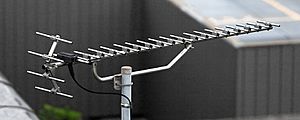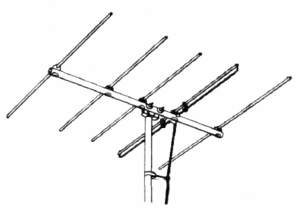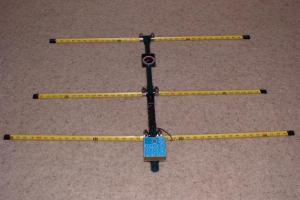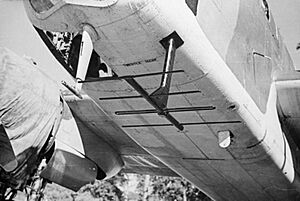Yagi–Uda antenna facts for kids
A Yagi–Uda antenna, often just called a Yagi antenna, is a special type of directional antenna. Think of it like a radio signal "flashlight" that sends or receives signals mostly in one direction. It's made of several parallel metal rods.
One rod, called the driven element, is connected to a radio transmitter (to send signals) or a radio receiver (to get signals). The other rods are called passive elements because they aren't directly connected. These include a reflector (usually one, placed behind the driven element) and one or more directors (placed in front).
These passive rods help focus the radio waves. They catch waves from the driven element and then re-send them. By doing this, they make the radio waves combine in a way that boosts the signal in one direction. This makes the antenna much better at sending or receiving signals from that specific direction.
Yagi antennas are very common. You've probably seen them on rooftops as television antennas. They are also used for radar, point-to-point communication, and by radio amateurs for long-distance talks. They are light, cheap, and simple to build.
Contents
Who Invented the Yagi Antenna?
The Yagi–Uda antenna was invented in Japan in 1926. The main inventor was Shintaro Uda from Tohoku University. His boss, Hidetsugu Yagi, also played a part.
Even though Uda did most of the practical work and experiments, the antenna became more famous under Yagi's name. This might be because Yagi wrote the first English article about it in 1928. Yagi also filed a patent for the idea in Japan without Uda's name, and later sold the patent to companies like Marconi and RCA.
Yagi antennas were first widely used during World War II. They were important for radar systems in Japan, Germany, the United Kingdom, and the United States. After the war, they became very popular for home television antennas.
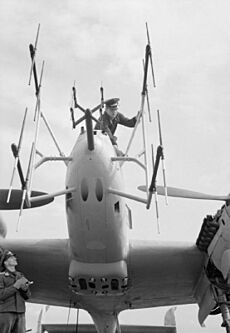
How Does a Yagi Antenna Look?
A typical Yagi–Uda antenna has several thin, parallel rods. Each rod is about half a wavelength long (this depends on the radio frequency it's designed for). These rods are usually attached to a long central bar called a "boom."
- Driven Element: This is the rod in the middle that connects to your radio or TV. It's usually a half-wave dipole or a folded dipole.
- Reflector: This rod is slightly longer than the driven element. It's placed behind the driven element, away from the direction the antenna is pointing.
- Directors: These rods are slightly shorter than the driven element. They are placed in front of the driven element, in the direction the antenna is pointing. There can be one or many directors.
These extra rods (reflectors and directors) are not wired up. They simply catch and re-send radio waves from the driven element. This helps shape the antenna's signal pattern. The distance between the rods is usually about one-tenth to one-quarter of a wavelength.
The more directors an antenna has, the stronger its signal can be in one direction. Usually, only one reflector is needed because adding more doesn't help much. Some Yagi antennas have more than 40 directors!
How Does a Yagi Antenna Work?
Imagine radio waves coming from the driven element. These waves hit the reflector and directors. Because these rods are slightly different lengths, they re-send the waves with a slightly different timing (or "phase").
- Directors: These are shorter. They make the waves they re-send arrive at the front of the antenna at just the right time to add up with the waves from the driven element. This makes the signal stronger in the forward direction.
- Reflector: This is longer. It makes the waves it re-send arrive at the front of the antenna in a way that helps the directors. In the backward direction, the waves from the reflector and driven element cancel each other out. This makes the signal much weaker behind the antenna.
So, all the waves from the different rods combine perfectly in one direction (the "forward" direction, where the directors are). They cancel each other out in the opposite direction. This creates a strong, focused beam of radio waves.
Designing Yagi Antennas
Designing a Yagi antenna isn't simple. There are many things to consider, like:
- The length of each rod.
- The distance between the rods.
- The thickness of the rods.
All these factors affect how well the antenna works, its signal strength (gain), and how it connects to your radio. Because it's so complex, engineers often use computer programs to simulate and test designs. Sometimes, they even build and test different versions in real life to find the best one.
One common way to design them is to start with existing designs. For example, the United States National Bureau of Standards (NBS) published some basic designs that are still used today.
Yagi Antennas in History
The Yagi antenna was first widely used during World War II for radar systems on aircraft. It was chosen because it was simple and could point its signal in a specific direction. Interestingly, even though it was invented in Japan, many Japanese engineers didn't know about the design until later in the war! They found out when they captured notes from a British radar technician that mentioned "yagi antenna."
You can see Yagi antennas on many WWII aircraft, especially those used for patrolling the seas or fighting at night. They were often placed under the wings or on the nose of the plane. For example, the German Morgenstern radar used a special "double-Yagi" design.
After World War II, Yagi antennas became very popular for receiving television broadcasting signals on rooftops. They were also used for FM broadcasting radio in areas where the signal was weak.
One challenge with Yagi antennas is their "bandwidth." This means they work best over a narrow range of frequencies. For TV, which uses many different channels, this was a problem. Engineers solved this by making more complex Yagi designs or combining them with other antenna types.
In 1995, the Yagi–Uda antenna was recognized as an IEEE Milestone, which is a special honor for important inventions in electrical engineering.

Images for kids
-
A modern high-gain UHF Yagi television antenna with 17 directors, and one reflector (made of four rods) shaped as a corner reflector
-
Drawing of Yagi–Uda VHF television antenna from 1954, used for analog channels 2–4, 54–72 MHz (U.S. channels). It has five elements: three directors (to left) one reflector (to right) and a driven element which is a folded dipole (double rod) to match the 300 Ω twin lead feedline. The beam direction (direction of greatest sensitivity) is to the left.
-
Quartet of two-dipole Yagi arrays (Hirschgeweih) of the German FuG 220 VHF-band radar on the nose of a late-World War II Bf 110 night fighter aircraft
-
Close-up of Yagi arrays of the ASV Mark II radar fitted beneath a Bristol Beaufort aircraft for anti-submarine warfare
-
A three-element Yagi–Uda antenna used for long-distance (skywave) communication in the shortwave bands by an amateur radio station. The longer reflector element (left), the driven element (centre), and the shorter director (right) each have a so-called trap (parallel LC circuit) inserted along their conductors on each side, allowing the antenna to be used on more than one frequency band.
See also
- Antenna (radio)
- Antenna array
- Radio direction finder


